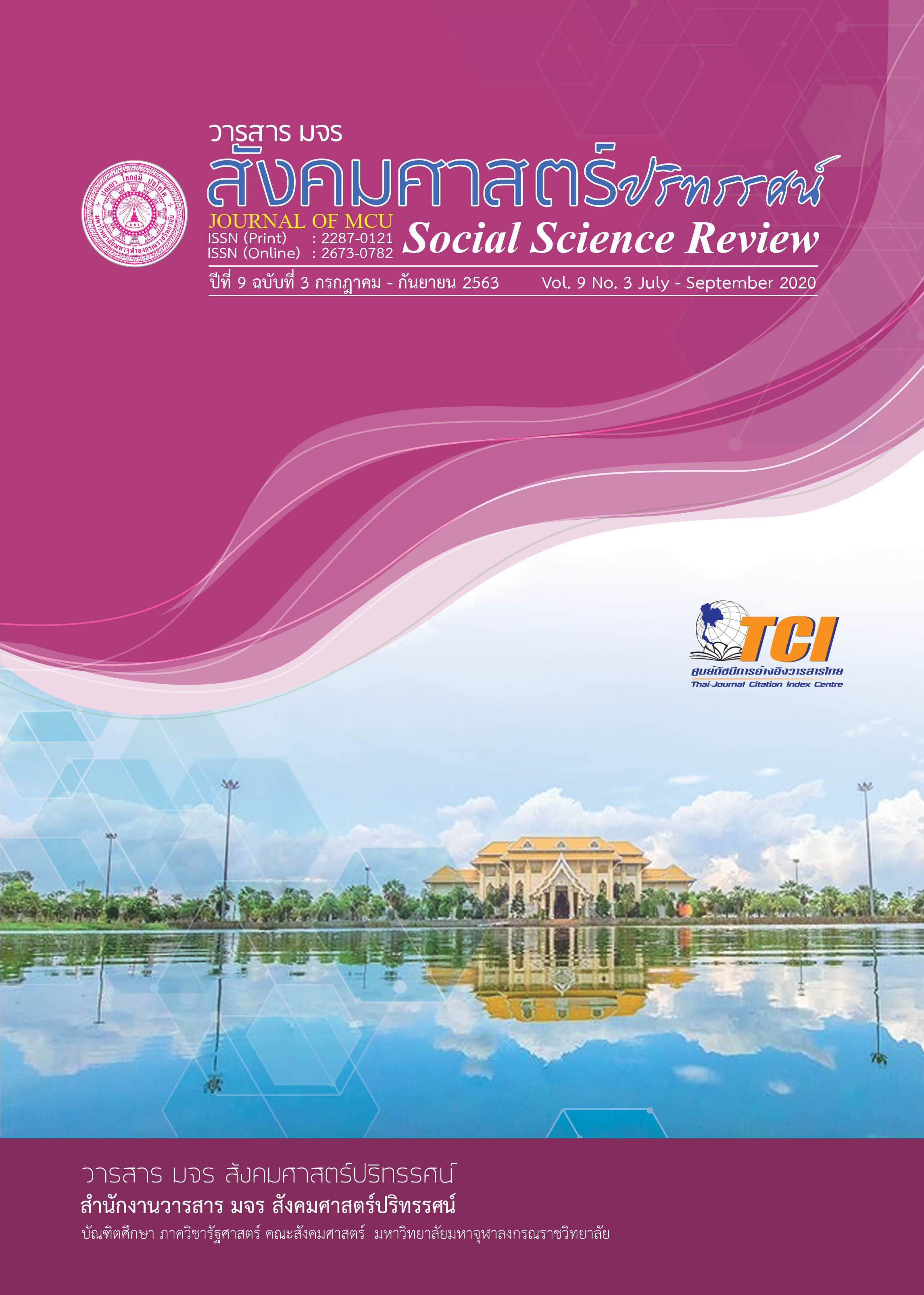THE DEVELOPMENT OF LEARNING MODEL TO ENHANCE PRATHOMSUKSA FIVE STUDENT’S PROBLEM SOLVING ABILITY FOCUSING ON KWAN PHAYAO RESERVATION IN THE SOCIAL STUDIES, RELIGION AND CULTURE LEARNING AREAS
Keywords:
Learning Model, Problem Solving Skills, Kwan PhayaoAbstract
The objectives of this research were to study and fundamental analyze, developing and verifying the effectiveness of model, experiment model and investigating satisfaction. The participants of this study were 25 students who were studying in primary level, P.5/1. Percentage, Mean, S.D. (Standard Deviation) and dependent statistics were used to analyze data. The results of this research revealed that: 1) Learners were expected to be developed with the balance of physical, knowledge, and moral mixture. Students were able to build their own knowledge management. 2) The learning model created in this research was called “B 4P SPC Model”. There were eight learning steps in this model namely Background Presentation (Step 1: B), Problem Issue (Step 2: P), Problem Comprehension (Step 3: P), Problem Solution (Step 4: P), Problem Solution Method (Step 5: P), Selecting the Best Choice (Step 6: S), Problem-solving and Action planning (Step 7: P), and Conclusion and Evaluation (Step 8: C). The model was assessed to examine for its suitability and efficiency, and it was found that the mean () was at 4.45 ,S.D =0.16. While the efficiency value (E1/ E2) of the model was 84.19/83.61. 3) From result after using the model, it showed that:1) Pretest score for Problem-solving ability of students was 13.60 compared with the post-test score was 24.52. The result could be concluded that statistical significance of post-test score was higher than it had been before at 0.1. 2) The mean pretest score for students’ post learning outcome was 14.49; however ,the post-test score was 24.96.lt showed that the statistical significance was higher than before at 0.1.4) It was found that students’ satisfaction with the model was at highest level(
= 4.61,S.D.= 0.01).
References
เจันทร์ทิพย์ มีแสงพันธ์. (2563). การพัฒนาทักษะทางวิทยาศาสตร์และเทคโนโลยี โดยการจัดการเรียนรู้ แบบบูรณาการสตีมผ่านกระบวนการสืบเสาะหาความรู้ สำหรับนักเรียน ชั้นประถมศึกษาปีที่ 3 โรงเรียนสุพรรณภูมิ จังหวัดสุพรรณบุรี. วารสาร มจร สังคมศาสตร์ปริทรรศน์, 9(2), 209-222.
พิณทิพย์ วิจิตรกลางและสุวิมล กฤชคฤหาสน์. (2563). การเปรียบเทียบสมรรถนะทางคณิตศาสตร์ระหว่างการจัดกิจกรรมการเรียนรู้โดยใช้ยุทธวิธีเมตาคอกนิชันกับการเรียนรู้แบบร่วมมือด้วยเทคนิค STAD ของนักเรียนชั้นมัธยมศึกษาปีที่ 6 โรงเรียนวังม่วงวิทยาคม. วารสาร มจร สังคมศาสตร์ปริทรรศน์, 9(1), 233-243.
พีชญาณ์ พานะกิจ. (2558). การพัฒนารูปแบบการสอนเพื่อส่งเสริมความสามารถในการแก้ปัญหาอย่าง สร้างสรรค์และนวัตกรรมทางวิทยาศาสตร์ของนักเรียนชั้นประถมศึกษา (วิทยานิพนธ์ปริญญาปรัชญาดุษฎีบัณฑิต สาขาวิชาหลักสูตรและการสอน). นครปฐม: มหาวิทยาลัยศิลปากร.
โรงเรียนเทศบาล 4 (ภูมินทร์ราษฎร์นุกูล). (2560).รายงานการประเมินตนเองโรงเรียนเทศบาล 4 (ภูมินทร์ราษฎร์ นุกูล). พะเยา: โรงเรียนเทศบาล 4 (ภูมินทร์ราษฎร์นุกูล).
วัชรา เล่าเรียนดี. (2556). รูปแบบและกลยุทธ์การจัดการเรียนรู้เพื่อพัฒนาทักษะการคิด (พิมพ์ครั้งที่ 10). นครปฐม: คณะศึกษาศาสตร์ มหาวิทยาลัยศิลปากร.
ศิริพร เอมสวัสดิ์และสุวิมล กฤชคฤหาสน์. (2563). การศึกษาการจัดเรียนการสอนแบบแนะให้รู้คิดร่วมกับการจัดการเรียนรู้เชิงรุก เรื่อง อสมการ ที่มีต่อทักษะและกระบวนการทางคณิตศาสตร์ ของนักเรียน ชั้นมัธยมศึกษาปีที่ 4 โรงเรียนมัธยมฐานบินกำแพงแสน. วารสาร มจร สังคมศาสตร์ปริทรรศน์, 9(1), 186-197.
ศิริลักษณ์ ตรีสินธุ์. (2555). การพัฒนารูปแบบคอมพิวเตอร์สนับสนุนการเรียนรู้ร่วมกันเพื่อพัฒนาความสามารถในการคิดแก้ปัญหาของนักศึกษาครุศาสตร์อุตสาหกรรม.วารสาร ศึกษาศาสตร์, 36(4), 72-79.
สิริภรณ์ สุริวงษ์และคณะ. (2563). การศึกษาผลการจัดการเรียนรู้แบบเน้นประสบการณ์ และการเรียนรู้จากบทเรียน คอมพิวเตอร์ช่วยสอน ที่มีต่อทักษะพื้นฐานทางวิทยาศาสตร์ของเด็กปฐมวัย. วารสาร มจร สังคมศาสตร์ปริทรรศน์, 9(1), 59-68.
สุวิทย์ มูลคํา. (2551). ครบเครื่องเรื่องการคิด (พิมพ์ครั้งที่ 9). กรุงเทพฯ: ห้างหุ้นส่วนจํากัดภาพพิมพ์.
อำพล พาจรทิศ. (2559). การพัฒนารูปแบบการสอนเพื่อพัฒนาทักษะการแก้ปัญหาสำหรับนักเรียนโรงเรียน นายร้อยพระจุลจอมเกล้า (ปริญญาการศึกษาดุษฎีบัณฑิต สาขาเทคโนโลยีการศึกษา). ชลบุรี: มหาวิทยาลัยบูรพา.
Kruse, K. (2008). Introduction to Instructional Desing and the ADDIE Modle. Retrieved November 29, 2015, from http://www.e-learningguru.com /articles/art21
Downloads
Published
How to Cite
Issue
Section
License
Copyright (c) 2020 Journal of MCU Social Science Review

This work is licensed under a Creative Commons Attribution-NonCommercial-NoDerivatives 4.0 International License.
In order to conform the copyright law, all article authors must sign the consignment agreement to transfer the copyright to the Journal including the finally revised original articles. Besides, the article authors must declare that the articles will be printed in only the Journal of MCU Journal of Social Sciences. If there are pictures, tables or contents that were printed before, the article authors must receive permission from the authors in writing and show the evidence to the editor before the article is printed. If it does not conform to the set criteria, the editor will remove the article from the Journal without any exceptions.





